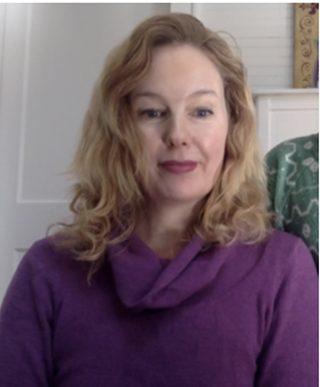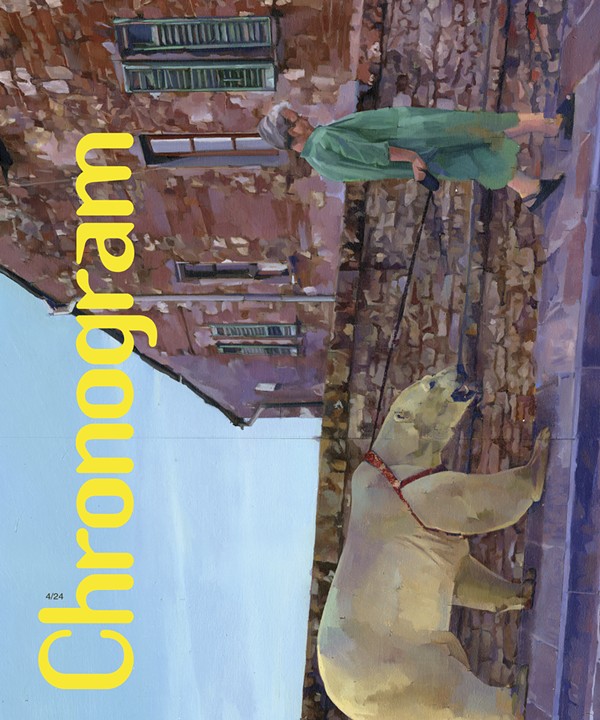
Like the rapid evolution of technology; like the revolution posed by cryptocurrency; like America's changing notion of where we should all hang out, Colborn Bell's home is in a bit of limbo. "Everything in my life is pretty ad hoc," says the financier and founder of the Museum of Crypto Art. "I moved here last December and have been traveling like nobody's business ever since." "Here" is an industrial corner of Kingston's Rondout neighborhood, up the hill from Feeney's Shipyard, which Bell chose for it's mix of peace, quiet, and community.
As well as his home, it's the physical manifestation of the Museum of Crypto Art, which was founded online in early 2020 and dedicated to showcasing the depth and breadth of digital art. Bell's abode is in an open-concept, loft-like first-floor space. In one corner, the kitchen—caught design-wise between phases in the Rondout's evolution—juxtaposes a suite of modern appliances with an Art Deco crystal chandelier and colorful lamps salvaged from the Russian Tea Room. In another corner, a workstation with multiple screens and piles of books and papers is where Bell oversees the operations of MoCA and curates his growing collection of NFT art.

At the back of the space, two sliding barn doors hide his bedroom. And everywhere, lined up along the red brick walls, stacked in corners—some of it hanging—are prints and painted canvases. "I end up with a lot of art," he explains. "Because people selling NFTs often also give you the physical piece." Storage, admits the visionary and virtual art collector, is a bit of a problem.
Bell sees no irony in the fact that he's located the headquarters of his forward-thinking, 21st-century project in a deconsecrated 1884 Catholic church. Maybe, suggests Bell, the 7,400-square-foot building, the former Sacred Heart of Jesus, hand built by parishioners, is the ideal location for his particular live/work arrangement. "I've always been fascinated by the reappropriation of sacred symbols," he says. "And I also like exploring the idea of the third place."

Based on a theory first explained by sociologist Ray Oldenburg, a community's third place (after homes and jobs) is where people spend their free time. Traditionally a place of worship, and often in modern times a barber shop or bar (think "Cheers"), the third place is easily accessible and essential to free-flowing banter and the exchange of ideas. Bell believes third spaces throughout the globe were already in trouble before the pandemic, and that the lockdown pushed the issue further.
"So many people have tried to find their third place online, but that's just led to a fragmented community and in America we have a real problem of trust," he says. "People are being forced to change and that scares them. I find the best way to help people open their mind to the possibilities on hand is to invite them to reconsider new forms of art."

Third Place Transitional
Bell grew up in California and then moved to New York to attend college at Columbia. He majored in economics and psychology, but Columbia's core curriculum, which included a rigorous focus on elements of Western philosophy, art, history, and music, left a lasting impression on his professional trajectory.After college, he worked as an investment banker before becoming involved with impact investing and the world of finance. This lead him to the world of cryptocurrency, which became a revelation for him. "Once I began to accept Bitcoin as a new form of money, everything began to change for me," he says. "Having self-custody over your own assets is very empowering. Instead of depending on a bank, you depend on yourself."

Bell became disillusioned with digital currency when, like many things in both the art and tech world, its original, idealistic intent was infiltrated with bad actors. However, digital currency had already led him into a new frame of mind, one that had him reconsidering the world of art.
"Like crypto currency, crypto art is decentralized and by its very nature crosses all sorts of boundaries. It brings a lot of new people into the ecosystem on the basis of the visual language," he says. "Visual language is more of global language. Unlike social media, with algorithms that thrive on division, crypto art is authentic. It comes from individual artists and when you begin to collect art it forces you to interrogate what you care about and why, by way of the images and symbols you're exposing yourself to."

After nine years in New York City, Bell moved to the Dutchess County town of Milan, where he lived a solitary life in the woods for three years. It was a time of reflection when he really reconsidered how he wanted to spend his time. "I work in extremes," he explains. "After so many years in New York City, I needed to redefine my personal identity. I think a lot of that was baked into this project."
He launched the virtual museum at the beginning of 2020, a prescient time for virtual enterprises and the accelerated idea exchanges they would spur. As the museum grew and his nexus of artists across the globe expanded, Bell realized it was time to find a brick-and-mortar location to match the space he was creating online. He found the church in 2021 and by the end of the year it was his.
Think Global Rooted in the Local
While the nature of the museum is cutting edge and the participants are global, Bell's mission is squarely rooted in Hudson Valley tradition. "I'm continuing a long tradition of artists and creators coming to the region for peace and quiet, but also maybe more freedom," he says. "This space is helping to facilitate that for others and also getting people interested in and showcasing digital art in new and novel ways." The church's second floor, the original nave, was ideally suited to become the museum's brick-and-mortar gallery. Fully refurbished by a previous owner, the 3,000-square-foot space features 20-foot vaulted ceilings and two walls of ornate Tiffany stained glass. Flooded with light, the space also features exposed timber beams and hardwood floors.
Throughout the room, along both the refurbished brick walls and against the raw timber beams, is digital art displayed on screens, interspersed with sculpture and paintings on canvas. While it's based in the virtual world, Bell has made a point to meet most of the artists featured in the permanent collection in person. This has required extensive travel, but it lends a depth of connection to the space so rooted in the Rondout location.
"There is just an incredible number of talented digital artists all over the globe," he says. "The connections I've made online with the artists have been some of the most genuine. People all over the world have invited me into their homes. It's been immediately familial. The digital art world has become a true third place where people connect."

Bell's plan is to bring that spirit of connection and conversation—that new third space—into the former church, recongregating around art. Off the central space, two church offices have been turned into bedrooms lending the space to artist residencies. The large open nave, with its rolling acoustics, has also been the site of musical events. "It's a space where imagination and innovation can flourish," says Bell of his plans. Through the church's windows, cranes loading boats in Feeney's shipyard, a nearby trestle bridge and the hustle and bustle of the neighboring Rondout are in full view. "I think art is probably the best place to start the conversation," he adds. The collection can be viewed at Museumofcryptoart.com.


















